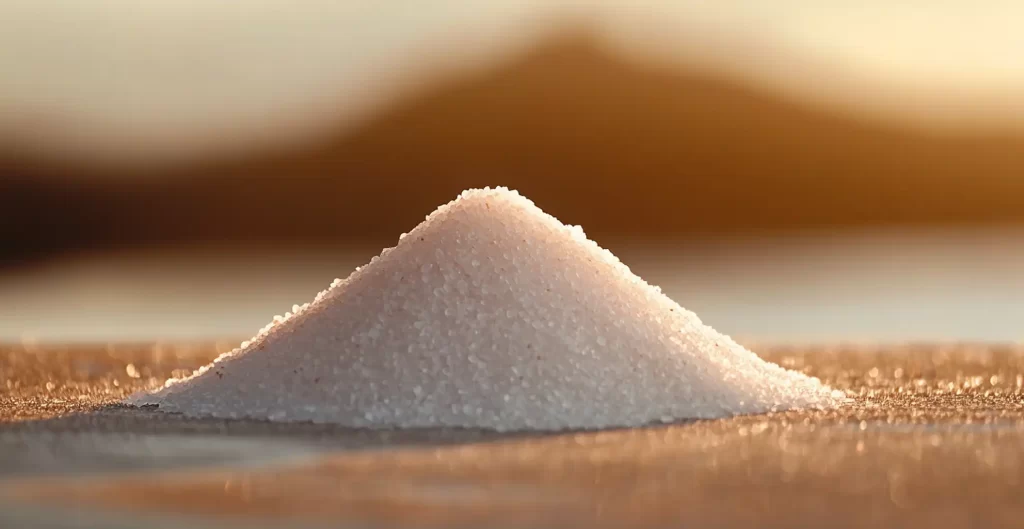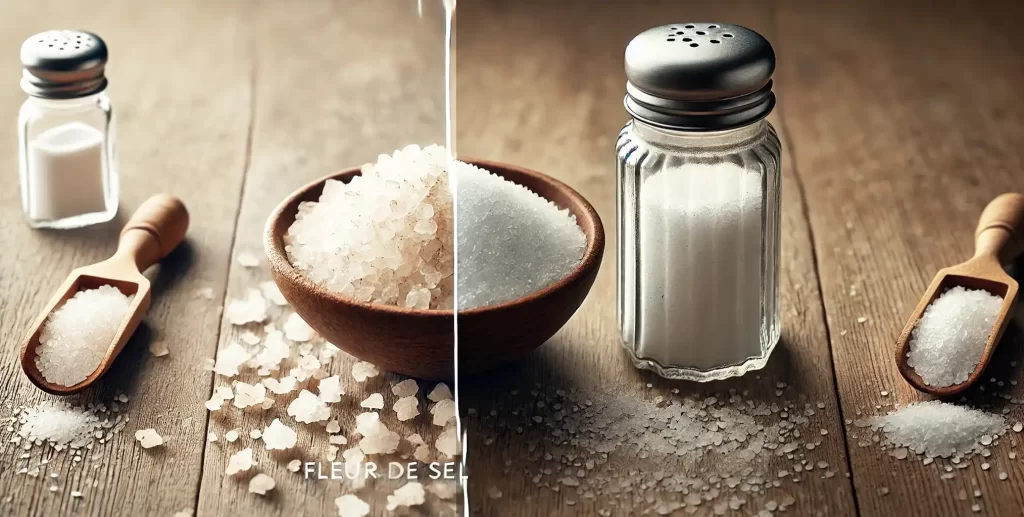Salt is one of the most essential ingredients in any kitchen, but not all salts are created equal. Among the many varieties, Fleur de Sel stands out as a premium, artisanal salt prized by chefs and gourmands worldwide. Unlike ordinary table salt, Fleur de Sel is hand-harvested from seawater and has a delicate texture, distinct flavor, and numerous health benefits.
Understanding the difference between Fleur de Sel and table salt can elevate your cooking and help you appreciate the craftsmanship behind this luxurious finishing salt. In this article, you’ll discover:
- How Fleur de Sel is harvested and why it’s so rare.
- The unique flavor profile that sets it apart from regular salt.
- Creative ways to use it to enhance your dishes.
Ready to elevate your seasoning game? Let’s dive in!
Why Is Fleur de Sel Considered a Premium Ingredient?
Fleur de Sel is often referred to as the “caviar of salts,” and for good reason. Here’s why it’s so special:
- Rarity: Unlike mass-produced table salt, Fleur de Sel can only be harvested under specific weather conditions and in limited quantities. One salt pan may yield just a few pounds of Fleur de Sel each day, making it a rare and valuable commodity.
- Flavor and Texture: Fleur de Sel has a delicate crunch and a more complex flavor profile compared to table salt. It’s less salty and more mineral-forward, with subtle hints of the sea. This unique flavor enhances dishes without overpowering them.
- Natural and Unrefined: Unlike refined table salt, which is stripped of its minerals and often contains additives, Fleur de Sel is completely natural. It retains beneficial trace minerals that contribute to its taste and nutritional value.
- Gourmet Appeal: Used primarily as a finishing salt, Fleur de Sel is sprinkled over dishes just before serving to enhance flavors and add a subtle crunch. From gourmet desserts to roasted vegetables and fine meats, it’s a staple in high-end kitchens around the world.

What Is Table Salt?
Table salt is the most commonly used salt in households worldwide. It’s the fine, white salt you’ll find in salt shakers at restaurants and kitchen tables. While it serves the essential purpose of seasoning food and providing the body with sodium, it’s vastly different from unrefined salts like Fleur de Sel.
How Is Table Salt Produced?
Table salt undergoes an extensive refining process that strips it of its natural minerals. It’s typically mined from underground salt deposits and then heavily processed to achieve its smooth, fine texture and long shelf life.
Here’s a breakdown of how table salt is produced:
- Refining: The raw salt is crushed, boiled, and purified to remove impurities and minerals.
- Bleaching: The salt is chemically treated to achieve its bright white color.
- Anti-Caking Agents: Additives such as calcium silicate or magnesium carbonate are added to prevent clumping.
- Fortification: Most table salts are fortified with iodine, a nutrient that helps prevent thyroid problems, especially in populations where iodine deficiency is common.
Additives in Table Salt
One of the defining characteristics of table salt is the inclusion of various additives. These serve different purposes, from preventing clumping to providing essential nutrients. Here are the most common additives found in table salt:
- Anti-Caking Agents: These are added to prevent moisture absorption and keep the salt free-flowing. While they’re considered safe, some people prefer unrefined salts to avoid these additives.
- Iodine: Added to prevent iodine deficiency, iodized table salt has become a primary source of this essential mineral in many diets worldwide.
Key Differences from Fleur de Sel
Compared to Fleur de Sel, which is natural, hand-harvested, and rich in minerals, table salt is a processed product that lacks the complexity and nutritional profile of unrefined salts. While table salt is more accessible and cost-effective, it doesn’t offer the same delicate flavor or artisanal quality.
Would you like a comparison chart between table salt and Fleur de Sel to add more value to your blog? 😊
Key Differences Between Fleur de Sel and Table Salt
When choosing between Fleur de Sel and table salt, understanding their key differences can elevate your cooking experience. While both serve the essential function of enhancing flavor, they vary significantly in texture, taste, and nutritional value.

Texture and Appearance
One of the most noticeable differences between Fleur de Sel and table salt is their texture and appearance, which directly impacts how they’re used in cooking.
Fleur de Sel: Flaky, Delicate Crystals
Fleur de Sel is prized for its light, flaky crystals that form naturally on the surface of seawater as it evaporates. These delicate crystals are hand-harvested and carefully dried to retain their unique structure. The irregular shape and size of the crystals create a crunchy texture when sprinkled on food, making it ideal as a finishing salt rather than for cooking.
Because of its flaky texture, Fleur de Sel dissolves more slowly than table salt. This slower dissolution enhances the sensory experience, allowing diners to experience the satisfying crunch followed by the burst of salty flavor.
✅ Pro Tip: Fleur de Sel works best as a final touch on dishes like roasted vegetables, fresh salads, and gourmet desserts. Its appearance also makes it visually appealing when sprinkled on food.
Table Salt: Fine, Uniform Grains
In contrast, table salt is made of fine, consistent grains that have been heavily processed. These grains are refined and stripped of impurities to create pure sodium chloride. The result is a fine, powdery texture that dissolves quickly in liquids, making it suitable for everyday cooking and baking.
However, table salt lacks the crunch and elegance of Fleur de Sel, making it less ideal for finishing dishes. The uniform grains can also result in an overly salty taste when used as a topping.
✅ Pro Tip: Use table salt in recipes where the salt will dissolve fully, such as soups, stews, and baked goods.
Taste Profile
The taste of salt plays a crucial role in how we perceive flavors in food. The way salt is processed and harvested can significantly impact its flavor profile.
Fleur de Sel: Complex and Nuanced Flavors
Fleur de Sel offers a subtler, more complex taste than table salt. Its flavor profile is often described as having hints of ocean air and natural minerals, which adds a depth that table salt lacks. Because it retains trace amounts of seawater and minerals during the harvesting process, Fleur de Sel brings a more natural, layered flavor to dishes.
This nuanced flavor makes it ideal for elevating simple dishes. Even a small sprinkle of Fleur de Sel can transform basic recipes into gourmet creations.
✅ Perfect Pairings: Fleur de Sel enhances the flavor of dishes like grilled meats, roasted vegetables, chocolates, and caramel desserts.
Table Salt: Straightforward Salty Taste
Table salt delivers a basic, straightforward salty flavor without any additional complexity. This is because it’s stripped of natural minerals during processing, resulting in a pure sodium chloride product.
While it serves its purpose in seasoning food, it lacks the depth of flavor that Fleur de Sel provides. Additionally, the overuse of table salt can make food taste overwhelmingly salty rather than enhancing its natural flavors.
✅ Use in Everyday Cooking: Table salt is perfect for general seasoning during cooking, but it’s not ideal for finishing dishes.
Nutritional Value
The nutritional value of salt depends on how it’s processed and the minerals it retains. Fleur de Sel offers some added benefits due to its natural harvesting process.
Fleur de Sel: Retains Natural Minerals
One of the unique characteristics of Fleur de Sel is that it retains trace minerals like magnesium, calcium, and potassium, which contribute to its complex flavor and slight health benefits.
While it’s still salt and should be consumed in moderation, these naturally occurring minerals give Fleur de Sel a slight nutritional edge over refined table salt. The higher moisture content in Fleur de Sel also means that it contains slightly less sodium per teaspoon compared to table salt.
✅ Did You Know? The natural minerals in Fleur de Sel can help balance electrolytes in the body, making it a more wholesome choice for finishing dishes.
Table Salt: Stripped of Minerals
In contrast, table salt undergoes extensive refining, during which natural minerals are removed. The refining process leaves behind pure sodium chloride with anti-caking agents and often iodine added to prevent clumping and to support thyroid health.
While table salt provides essential iodine, it lacks the natural minerals that make Fleur de Sel a more wholesome option.
✅ Important Note: While table salt is useful for baking and everyday cooking, it’s not the best choice for finishing dishes or for those looking to reduce sodium intake without sacrificing flavor.
Quick Comparison Table
| Feature | Fleur de Sel | Table Salt |
|---|---|---|
| Texture | Flaky, delicate crystals | Fine, uniform grains |
| Taste | Complex, nuanced flavors | Basic salty taste |
| Nutritional Value | Retains trace minerals (magnesium, etc.) | Stripped of natural minerals |
| Best Uses | Finishing dishes | Everyday cooking and baking |
Culinary Uses of Fleur de Sel
Fleur de Sel is often referred to as the “caviar of salts” due to its delicate texture, rich flavor profile, and ability to enhance dishes with a gourmet touch. Unlike regular table salt, which is primarily used during cooking, Fleur de Sel is best known as a finishing salt—a final sprinkle that brings out the best in both savory and sweet dishes. Below, we explore the best ways to use Fleur de Sel in your cooking and why chefs around the world favor it for elevating presentation and flavor.
Best Ways to Use Fleur de Sel in Cooking
Fleur de Sel is not your everyday salt meant for seasoning while cooking. Its unique properties make it best suited as a finishing salt—added at the end of the cooking process to preserve its delicate crystals and maximize flavor. When used correctly, it can transform simple dishes into gourmet experiences.
Here’s how to make the most of Fleur de Sel in your kitchen:
- Sprinkle it over freshly grilled meats like steak, chicken, or fish for a burst of flavor and crunch.
- Top fresh salads with a pinch of Fleur de Sel to add texture and enhance the natural flavors of the vegetables.
- Finish soups and pasta dishes with a light sprinkle to bring out a well-balanced, savory taste.
- Use it to garnish baked goods and desserts, like cookies, brownies, or caramel treats, to provide a subtle contrast to the sweetness.
✅ Pro Tip: Because Fleur de Sel is more expensive than regular salt, use it sparingly and only where it will make the biggest impact—right before serving.
Common Dishes Where Fleur de Sel Shines
Fleur de Sel’s versatility makes it a valuable addition to both savory and sweet dishes. Below are some of the most popular ways chefs use Fleur de Sel to enhance their culinary creations.
🍫 1. Chocolates and Caramels
One of the most beloved pairings in the world of desserts is Fleur de Sel with chocolate or caramel. The salt’s delicate crystals add a contrasting crunch and a burst of salty flavor that balances the richness of these sweet treats.
- Salted Caramel Sauce: A drizzle of homemade caramel sauce sprinkled with Fleur de Sel creates the perfect balance of salty and sweet.
- Dark Chocolate Truffles: Dusting the top of chocolate truffles with Fleur de Sel enhances the cocoa flavor and provides a delightful texture.
- Brownies and Cookies: Adding Fleur de Sel to the top of brownies or cookies gives them a gourmet finish and elevates their taste.
✅ Pro Tip: The salty-sweet combination is a popular trend in modern cuisine, and Fleur de Sel is the secret ingredient that brings it to life.

🥩 2. Grilled Meats and Steaks
Fleur de Sel is a favorite finishing salt for grilled meats, especially steaks. Its large, flaky crystals add a satisfying crunch and enhance the natural flavors of the meat without overpowering it.
- Grilled Ribeye or Filet Mignon: A light sprinkle of Fleur de Sel right before serving takes a perfectly grilled steak to the next level.
- Roasted Chicken: Adding a pinch of Fleur de Sel on top of roasted chicken brings out its savory notes and adds depth to the flavor.
- Grilled Fish: Whether it’s salmon, halibut, or sea bass, a dash of Fleur de Sel adds a touch of elegance and flavor to seafood dishes.
✅ Pro Tip: Because of its natural moisture content, Fleur de Sel doesn’t dissolve as quickly as table salt, making it ideal for adding a final touch of flavor and texture to grilled or roasted meats.
🥗 3. Fresh Salads and Vegetables
Fleur de Sel is also an excellent way to add complexity to fresh salads and vegetable dishes. Its crunch and flavor can turn simple greens into a restaurant-quality dish.
- Caprese Salad: Sprinkling Fleur de Sel over slices of fresh mozzarella, tomatoes, and basil enhances the natural flavors of this classic Italian salad.
- Roasted Vegetables: Adding a final touch of Fleur de Sel to roasted vegetables like carrots, asparagus, or Brussels sprouts brings out their natural sweetness and earthy flavors.
- Avocado Toast: For a trendy and healthy snack, sprinkle Fleur de Sel on top of avocado toast for added flavor and texture.
✅ Pro Tip: Because vegetables have a natural sweetness, Fleur de Sel’s mineral-rich flavor profile complements them perfectly, bringing out their best qualities.
🍰 4. Baked Goods and Desserts
Fleur de Sel is increasingly being used in desserts and baked goods to create contrast and balance. Its crunchy texture adds an unexpected element to otherwise soft and sweet treats.
- Salted Caramel Cheesecake: A light dusting of Fleur de Sel on top of cheesecake enhances the caramel notes and provides a gourmet twist.
- Chocolate Chip Cookies: For an elevated take on classic cookies, sprinkle Fleur de Sel over the dough before baking for a salty-sweet experience.
- Cakes and Pastries: Adding Fleur de Sel to cakes, pastries, or pies gives them a sophisticated edge, making them taste like something from a high-end bakery.
✅ Pro Tip: Less is more when using Fleur de Sel in desserts. A small sprinkle is enough to create a big impact.
Why Chefs Prefer Fleur de Sel for Texture and Presentation
Chefs around the world favor Fleur de Sel for both its flavor-enhancing properties and visual appeal. Here’s why:
- Enhanced Texture: Fleur de Sel’s large, flaky crystals provide a satisfying crunch that regular salt cannot replicate. This texture is especially important in finishing dishes.
- Gourmet Presentation: Fleur de Sel adds a touch of elegance to dishes. The irregular crystals catch the light and give food a polished, professional look that enhances the dining experience.
- Flavor Boost Without Overpowering: Unlike regular salt, which can easily overpower a dish, Fleur de Sel provides nuanced seasoning that highlights the natural flavors of the ingredients.
✅ Did You Know? The irregular crystals of Fleur de Sel form naturally and vary in size and shape, making each pinch unique and visually stunning.
Is Fleur de Sel Healthier Than Table Salt?
When comparing Fleur de Sel to traditional table salt, it’s essential to consider both the nutritional profile and health implications of each. While Fleur de Sel is often seen as a healthier, more natural alternative, the reality is that all salt consumption should be moderate to avoid potential health risks. Below, we’ll explore the health benefits, risks, and differences between these two types of salt.
Discussion of Health Benefits and Risks
Fleur de Sel has a more natural and mineral-rich composition compared to heavily processed table salt. Since it is harvested directly from sea salt beds, it retains trace minerals like magnesium, potassium, and calcium—nutrients that are stripped away during the processing of table salt.
However, it’s important to note that both types of salt contain sodium, which, when consumed in excess, can contribute to high blood pressure, heart disease, and other health issues. The key difference is in how much sodium each type of salt delivers per serving and the added chemicals found in table salt.
| Comparison | Fleur de Sel | Table Salt |
|---|---|---|
| Source | Hand-harvested from sea salt beds | Mined and processed from underground salt deposits |
| Mineral Content | Retains natural minerals like magnesium | Stripped of minerals during processing |
| Sodium Content | Lower sodium per volume due to flaky texture | Higher sodium per volume |
| Additives | None | May contain anti-caking agents and iodine |
Lower Sodium Content in Fleur de Sel Compared to Table Salt
One of the main health benefits of Fleur de Sel is its lower sodium content per pinch compared to table salt. This is largely due to its flakier texture and larger crystals, which means you use less salt by volume to achieve the same level of seasoning.
For example:
- 1 teaspoon of Fleur de Sel contains less sodium than 1 teaspoon of table salt because the larger flakes take up more space, meaning you consume less salt overall.
However, it’s important to keep in mind that Fleur de Sel is still salt and should be used sparingly. Even though it has a lower sodium density, overconsumption can still pose health risks.
Importance of Moderation in Salt Consumption
Regardless of the type of salt you use, moderation is key to maintaining good health. Here are a few tips to keep your salt consumption in check:
- Use Fleur de Sel as a finishing salt rather than a cooking salt. This allows you to use smaller amounts while maximizing flavor.
- Focus on balanced seasoning. Pair Fleur de Sel with herbs, spices, and citrus to reduce the need for excessive salt.
- Be mindful of hidden sodium. Many processed foods and condiments contain high levels of sodium, so reducing added salt in home cooking can help balance your overall intake.
✅ Pro Tip: If you’re looking for a healthier alternative to regular table salt, Fleur de Sel can be a better option due to its natural mineral content and lower sodium density. However, it’s not a miracle health food and should still be used in moderation.
How to Choose and Store Fleur de Sel
To get the most out of Fleur de Sel, it’s essential to know how to choose a high-quality product and store it properly to maintain its freshness and texture. Since it’s a premium product, selecting the right type can make a big difference in both flavor and presentation.
Tips for Selecting High-Quality Fleur de Sel
When buying Fleur de Sel, you want to ensure you’re getting an authentic product that lives up to its gourmet reputation. Here’s what to look for:
- Origin Matters:
- The most authentic Fleur de Sel comes from Guérande, France, where it’s been harvested using traditional methods for centuries.
- Other reputable sources include Camargue in southern France and Portugal.
- Look for “Hand-Harvested” or “Artisanal” Labels:
- Authentic Fleur de Sel is harvested by hand using traditional wooden tools. Avoid products labeled as “sea salt” or “fine sea salt” as they may not be true Fleur de Sel.
- Check the Texture and Color:
- High-quality Fleur de Sel should have irregular, flaky crystals that are slightly off-white or light grey. If it looks overly refined or uniform, it’s likely not the real deal.
- Packaging:
- Fleur de Sel often comes in small jars or ceramic containers to preserve its freshness and texture. Avoid plastic packaging, which can absorb moisture and affect the quality of the salt.
Proper Storage to Maintain Freshness and Texture
Fleur de Sel is hygroscopic, meaning it absorbs moisture from the air. To keep it fresh and flaky, follow these storage tips:
- Store in an Airtight Container: Once opened, transfer your Fleur de Sel to an airtight glass or ceramic jar to keep it dry and prevent it from clumping.
- Keep It in a Cool, Dry Place: Avoid storing Fleur de Sel near heat sources or in humid environments, as this can cause the salt to harden or dissolve.
- Use a Wooden or Ceramic Spoon: To preserve the integrity of the crystals, use a non-metal spoon when scooping out Fleur de Sel.
✅ Pro Tip: Proper storage is essential for maintaining the delicate flavor and texture of Fleur de Sel. With the right care, your salt can last indefinitely without losing its quality.
FAQs About Fleur de Sel vs. Table Salt
Many people wonder if Fleur de Sel is worth the higher price tag and how it compares to regular table salt in terms of taste, quality, and usage. Here are some frequently asked questions to clear up any confusion.
Is Fleur de Sel Worth the Price?
Yes, if you’re looking for a luxury finishing salt that can elevate your cooking. While Fleur de Sel is more expensive than table salt, a little goes a long way, and its unique texture and flavor profile make it a worthwhile investment for gourmet meals.
Can I Replace Table Salt with Fleur de Sel?
Fleur de Sel is best used as a finishing salt rather than a cooking salt. It’s not ideal for replacing table salt in all recipes, especially those that require salt to dissolve during cooking. However, you can use Fleur de Sel to add the final touch to dishes for an enhanced dining experience.
Why Does Fleur de Sel Cost More?
The artisanal harvesting process of Fleur de Sel is labor-intensive, requiring skilled salt farmers to carefully skim the delicate salt crystals from the water’s surface. Its limited production and premium quality contribute to its higher price point compared to table salt, which is mass-produced using industrial methods.
✅ Fun Fact: Only a few regions in the world produce authentic Fleur de Sel, making it one of the most exclusive salts on the market.

